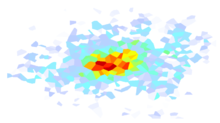3.9. Disclaimers¶
3.9.1. General Disclaimer¶
Warning
Some USGS information accessed through this page may be preliminary in nature and presented prior to final review and approval by the Director of the USGS. This information is provided with the understanding that it is not guaranteed to be correct or complete, and conclusions drawn from such information are the sole responsibility of the user. In addition, ShakeMaps are automatic, computer-generated maps and have not necessarily been checked by human oversight, so they may contain errors. Further, the input data is raw and unchecked, and may contain errors.
Contours can be misleading, since data gaps may exist. Caution should be used in deciding which features in the contour patterns are required by the data. Ground motions and intensities can vary greatly over small distances, so these maps are only approximate. In addition, the contours provided in the JSON files have been smoothed, and are thus not suitable for anything but plotting and approximate analysis.
Locations within the same intensity area will not necessarily experience the same level of damage, since damage depends heavily on the type of structure, the nature of the construction, and the details of the ground motion at that site. For these reasons, more or less damage than described in the intensity scale may occur. The ground motion levels and descriptions associated with each intensity value are based on recent damaging earthquakes. There may be revisions in these parameters as more data become available or due to further improvements in methodologies.
Large earthquakes can generate very long-period ground motions that can cause damage at great distances from the epicenter; although the intensity estimated from the ground motions may be small, significant effects to large structures (e.g., bridges, tall buildings, storage tanks) may be notable.
The utilization of DYFI data on ShakeMap, in addition to using recorded peak ground motions, is standard-operating-procedure for some ShakeMap operations, including the Global ShakeMap (GSM) system operated out of the USGS NEIC. The algorithmic strategy for including these data in ShakeMap is documented in the Technical Guide. As described by Wald et al. (2011), the ultimate discretion to use, filter, or overrule specific internet-based or historic intensities (or specific suspect strong motion data, for that matter) remains with the ShakeMap operators. A number of filtering and quality control strategies are in place (e.g., Wald et al., 2011), but erroneous or suspect data can not always be culled immediately. While we make efforts to provide consistent quality control of the data, the DYFI system depends upon open, citizen-science based input from the public. A number of studies have shown these data to be generally reliable, but the data reliability may vary from event to event. Moreover, macroseismic intensities are fundamentally non-unique: Differing polygonal aggregations for computing Community Decimal Intensities (CDI, using geocoded boxes or ZIP codes, for example, Wald et al., 2011) may yield varying intensity values at specific locations. [Historic or modern MMI or EMS-98 intensity assignments are also non-unique; the assignment can vary from expert to expert, the selection of areas may vary, and occasionally different structure types may indicated alternative intensities]. Changes to the size of the areas used to aggregate CDIs often trade off a greater number of responses per polygon (hence greater confidence in the derived intensity) against a more precise spatial location. DYFI data are routinely used on the GSM systems and other regional ShakeMap systems of the ANSS. DYFI data are not currently (as of 2016) used in the Northern or Southern California ShakeMap systems, in part due to the adequacy of strong-motion station coverage there.
3.9.2. ShakeMap Update Policy¶
Warning
ShakeMaps are preliminary in nature and will be updated as data arrives from a variety of distributed sources. Our practice is to improve the maps as soon as possible, but there are factors beyond our control that can result in delayed updates.
Also see: ShakeMap Operations, in particular ShakeMap Sources, Authoritativeness, and Versions.
